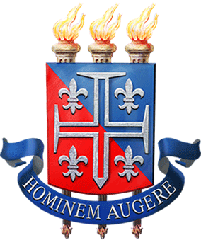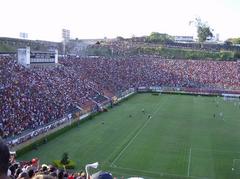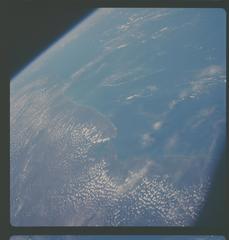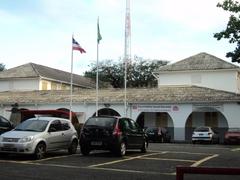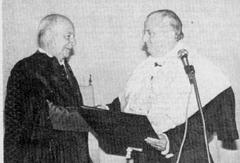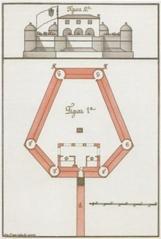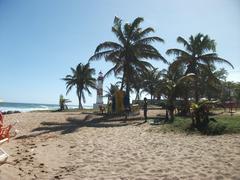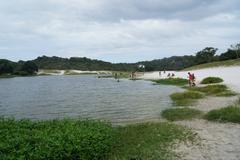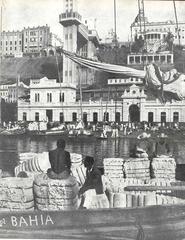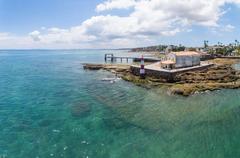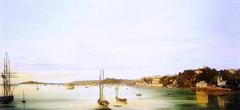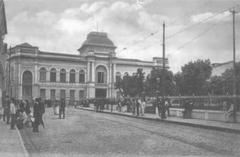São Marcelo Fort: Visiting Hours, Tickets, and Historical Insights for Salvador, Brazil
Date: 15/06/2025
Introduction
São Marcelo Fort, locally known as “Forte do Mar” and affectionately called the “Umbigo da Bahia” (Navel of Bahia), stands as one of Brazil’s most unique military monuments. Located on a small artificial island in Salvador’s Bay of All Saints, this 17th-century circular fortification is not only a testament to Renaissance military engineering but also a vibrant emblem of Salvador’s colonial heritage and cultural identity (Evendo; Wikipedia; The Rio Times). Though the fort’s interior is currently closed to the public for preservation, its silhouette remains an essential part of Salvador’s landscape, accessible through scenic boat tours and panoramic viewpoints.
This guide presents a comprehensive overview of São Marcelo Fort’s history, architecture, cultural significance, practical visiting advice, and nearby attractions—empowering travelers to appreciate and responsibly engage with this iconic Salvador historical site.
Table of Contents
- Introduction
- Historical Background and Construction
- Architectural Features and Innovations
- Role in Defense and Political History
- Cultural and Social Significance
- Conservation and Restoration Efforts
- Visitor Information
- Nearby Attractions and Integration with Salvador’s Heritage
- Frequently Asked Questions (FAQ)
- Conclusion
- References
Historical Background and Construction
São Marcelo Fort was constructed in 1623 to defend the then-capital of colonial Brazil, Salvador, from Dutch and French privateers. Strategically placed about 300 meters offshore on a reef bank, its unique circular design—a rarity in Brazil—was inspired by European Renaissance fortifications such as Italy’s Castel Sant’Angelo and Portugal’s Torre do Bugio (Wikipedia). The fort allowed for 360-degree artillery defense, a significant tactical advantage in protecting the bay’s entrance and the city’s thriving sugar trade.
Architectural Features and Innovations
The fort’s circular plan, approximately 45 meters in diameter and encompassing about 2,500 square meters, features thick stone walls (up to 3 meters wide) and two primary levels: a lower battery for heavy artillery and an upper platform for lookouts and additional firepower (Wikipedia). Its Renaissance influence is apparent not only in form and symmetry but also in adaptations to local environmental conditions—robust construction materials like local stone and lime mortar ensured resistance to saltwater and strong tides.
Key architectural highlights:
- Circular Design: Only one of its kind in Brazil, permitting all-around defense.
- Embrasures and Parapets: Permitted overlapping fields of artillery fire.
- Self-sufficiency: Barracks, storage rooms, cisterns, and a central courtyard.
- Lighthouse: Operated from 1857 to 1957, aiding navigation (Wikipedia).
- Modernizations: 20th-century upgrades included advanced artillery such as Krupp cannons.
Role in Defense and Political History
São Marcelo Fort’s strategic significance extended beyond colonial defense. It was pivotal during the Dutch invasions of the 17th century and later served as a prison for political detainees, including Bento Gonçalves, leader of the Farroupilha Revolution (salvadordabahia.com). The fort witnessed key historical events, such as the Sabinada revolt in 1837 and the bombardment during the “Política das Salvações” in 1912, marking its enduring role in Brazil’s evolving political landscape (Wikipedia).
Cultural and Social Significance
São Marcelo Fort is deeply woven into Salvador’s social fabric. Its form is visible from major city landmarks like Elevador Lacerda and Mercado Modelo, and it frequently appears in local art, music, and folklore (salvadordabahia.com). The fort is a site of legends—ranging from hidden treasures to ghostly tales—and has hosted cultural events, exhibitions, and even live music recordings. Although currently closed for interior visits, it remains a powerful symbol of Salvador’s resilience and multicultural identity.
Conservation and Restoration Efforts
Designated a National Historic and Artistic Heritage Site in 1938, São Marcelo Fort has been the focus of extensive preservation work led by the Instituto do Patrimônio Histórico e Artístico Nacional (IPHAN) (Wikipedia). Restoration projects have addressed structural stabilization, wall repairs, and the maintenance of docking facilities. While plans for a permanent maritime museum remain under discussion, ongoing efforts ensure the fort’s legacy is protected for future generations.
Visitor Information
Current Status, Visiting Hours, and Tickets
- Interior Access: Closed since 2011 for preservation, with rare exceptions for special events.
- Tickets: No admission tickets required for entry, as interior visits are suspended. Tickets are required for boat tours that approach the fort.
- Boat Tour Hours: Typically operate 8:00 AM to 5:00 PM, departing from Mercado Modelo and the Nautical Tourist Terminal (Evendo).
Access and Boat Tours
- Best Land Viewing Points: Elevador Lacerda, Castro Alves Square, and Contorno Avenue offer panoramic views.
- Boat Tours: Various operators offer 30–90-minute excursions providing close views and photographic opportunities. Some tours permit brief swims near the fort, but landing is not allowed to protect the structure.
- Booking: Purchase tickets at departure points or via official tourism websites. Always verify schedules and availability as they may change due to weather or restoration work.
Accessibility
- Onsite Accessibility: Due to the offshore location and the fort’s historic design, accessibility is limited. Boat boarding may be challenging for visitors with mobility impairments; consult operators in advance.
- Onshore Facilities: Restrooms, restaurants, and shops are available near departure points in the Comércio district.
Tips for Visitors
- Check official sources or the Salvador tourism website for current updates on access and tours.
- Visit during the dry season (August–March) for optimal weather.
- Bring sun protection, water, and a camera.
- Combine your visit with nearby attractions for a full Salvador experience.
- Use only licensed tour operators; life jackets are provided for safety.
Nearby Attractions and Integration with Salvador’s Heritage
- Pelourinho: A UNESCO World Heritage site known for its colonial architecture and vibrant culture.
- Forte de Santo Antônio da Barra & Forte de Nossa Senhora de Monte Serrat: Historic forts offering further insight into Salvador’s military past.
- Mercado Modelo & Elevador Lacerda: Landmarks providing cultural and historical context, as well as excellent views of the bay and fort.
Visiting these sites together offers a comprehensive understanding of Salvador’s layered history and cultural diversity (Bahia.ws).
Frequently Asked Questions (FAQ)
Is the interior of São Marcelo Fort open to visitors?
No, the fort has been closed for interior public visitation since 2011, except for rare special events.
How can I see São Marcelo Fort?
You can view the fort from panoramic city viewpoints or join licensed boat tours departing from Mercado Modelo or the Nautical Tourist Terminal.
Are guided tours available?
Yes, several operators offer guided boat tours that provide historical commentary and photo opportunities.
Do I need a ticket to visit the fort?
No tickets are needed to enter the fort as it’s closed, but boat tours require tickets.
Is the fort accessible for people with mobility issues?
Accessibility is limited due to the fort’s location and design. Consult boat operators for specific accommodations.
What are the best times to visit?
Dry season (August–March) and golden hour (early morning or late afternoon) for photography.
Conclusion
São Marcelo Fort remains a singular symbol of Salvador’s history, blending Renaissance military architecture, colonial defense, and vibrant cultural narratives. While its interior is currently off-limits, the fort’s majestic presence can be enjoyed through boat tours and panoramic land views, offering travelers a unique glimpse into Brazil’s maritime past. For the latest information on visiting hours, ticketing, and events, download the Audiala app and follow official Salvador tourism channels.
Plan your visit to Salvador’s historical treasures, and let São Marcelo Fort inspire your journey through the city’s enduring spirit and culture.
References
- Visiting São Marcelo Fort: History, Tickets, and Travel Tips for Salvador’s Iconic Sea Fort (Evendo)
- Visiting São Marcelo Fort: Hours, Tickets, and Architectural Wonders in Salvador (Wikipedia; The Rio Times)
- Visiting São Marcelo Fort: History, Tickets, and Salvador’s Iconic Historical Site (salvadordabahia.com)
- São Marcelo Fort Visiting Hours, Tickets & Guide to Salvador’s Historic Sea Fort (official Salvador tourism)
- Salvador’s Tourist Attractions and Architectural Heritage (Bahia.ws)

